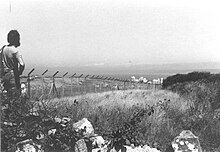Flamanville Nuclear Power Plant
| Flamanville Nuclear Power Plant | |
|---|---|
 | |
 | |
| Official name | Centrale Nucléaire de Flamanville |
| Country | France |
| Location | Flamanville, Manche |
| Coordinates | 49°32′14″N 1°52′57″W / 49.5372°N 1.8825°W |
| Status | Operational |
| Construction began | 1979 |
| Commission date | December 4, 1985 2019 (Flamanville 3 scheduled) |
| Operator | EDF |
| Nuclear power station | |
| Reactor type | PWR EPR |
| Reactor supplier | Framatome Areva |
| Power generation | |
| Units operational | 2 x 1,382 MW |
| Make and model | Alstom |
| Units under const. | 1 x 1,650 MW |
| Nameplate capacity | 2,764 MW |
| Annual net output | 17,917 GWh |
| External links | |
| Website | Areva site |
| Commons | Related media on Commons |
The Flamanville Nuclear Power Plant is located at Flamanville, Manche, France on the Cotentin Peninsula. The power plant houses two pressurized water reactors (PWRs) that produce 1.3 GWe each and came into service in 1986 and 1987, respectively. It produced 18.9 TWh in 2005, which amounted to 4% of the electricity production in France. In 2006 this figure was about 3.3%.
In 2006, before the start of construction of the EPR (unit 3), there were 671 workers regularly working at the two operational reactors.
The EPR (Flamanville 3) aimed to be safer than any previous reactor, but the project is three times over budget and years behind schedule. Various safety problems have been raised, including weakness in the steel used in the reactor.[1]
Unit 3
Construction on a new reactor, Flamanville 3, began on 4 December 2007.[2] The new unit is an Areva European Pressurized Reactor type and is planned to have a nameplate capacity of 1,650 MWe.
EDF has previously said France's first EPR would cost €3.3 billion[2] and start commercial operations in 2012, after construction lasting 54 months.[3]
On 3 December 2012 EDF announced that the estimated costs have escalated to €8.5 billion ($11 billion), and the completion of construction is delayed to 2016.[4] The next day the Italian power company Enel announced it was relinquishing its 12.5% stake in the project, and 5 future EPRs, so would be reimbursed its project stake of €613 million plus interest.[5][6]
In November 2014 EDF announced that completion of construction was delayed to 2017 due to delays in component delivery by Areva.[7]
In April 2015 Areva informed the French nuclear regulator, Autorité de sûreté nucléaire (ASN), that anomalies had been detected in the reactor vessel steel, causing "lower than expected mechanical toughness values". Further tests are underway.[8][9] Segolene Royal, Minister of Ecology, Sustainable Development and Energy in the Second Valls Government, has asked the producer for further details and possible consequences.[10]
Various safety problems have been raised, including weakness in the steel used in the reactor.[11] The safety of the Flamanville EPR plant has also been questioned due to the danger of flooding of the kind experienced during the 1999 Blayais Nuclear Power Plant flood.[12] In June 2015 multiple faults in cooling system safety valves were discovered by ASN.[13]
The EPR (Flamanville 3) aimed to be safer than any previous reactor, but as of 2016 the project is three times over budget and years behind schedule. In September 2015 EDF announced that the estimated costs had escalated to €10.5 billion, and the start-up of the reactor was delayed to the fourth quarter of 2018.[14]
References
- ^ Jennifer Rankin. Flamanville: France's beleaguered forerunner to Hinkley Point C, The Guardian, 27 July 2016.
- ^ a b "Construction of Flamanville EPR begins". World Nuclear News. 2007-12-04. Retrieved 2011-03-19.
- ^ "Flamanville 3 concrete poured". Nuclear Engineering International. 6 December 2007. Archived from the original on June 13, 2011. Retrieved 1 August 2011.
{{cite news}}: Unknown parameter|deadurl=ignored (|url-status=suggested) (help) - ^ "Le coût de l'EPR de Flamanville encore revu à la hausse". Le Monde. 3 December 2012. Retrieved 4 December 2012.
- ^ "Enel Drops Participation in Flamanville EPR as Project Costs Soar by $2.6B". POWER. 6 December 2012. Retrieved 14 August 2013.
- ^ "Enel and Edf Terminate their cooperation on EPR in France". Enel. 4 December 2012. Retrieved 14 August 2013.
- ^ Michael Stothard (18 November 2014). "EDF in fresh delay for flagship nuclear plant". Financial Times. Retrieved 21 November 2014.
- ^ "Flamanville EPR vessel anomalies under scrutiny". World Nuclear News. 7 April 2015. Retrieved 11 April 2015.
- ^ www.asn.fr: Anomalies de fabrication de la cuve de l’EPR de Flamanville. Communiqué de presse, 7 april 2015
- ^ 8. April 2015: Nucléaire: une nouvelle anomalie détectée sur l’EPR de Flamanville
- ^ Jennifer Rankin. Flamanville: France's beleaguered forerunner to Hinkley Point C, The Guardian, 27 July 2016.
- ^ The great lesson France has to learn from Fukushima Deciphering Fukushima, published 2011-03-08, accessed 2012-05-08
- ^ Henry Samuel (9 June 2015). "Faulty valves in new-generation EPR nuclear reactor pose meltdown risk, inspectors warn". Daily Telegraph. Retrieved 9 July 2015.
- ^ https://www.edf.fr/en/edf/press_release/Flamanville-EPR-optimised-project-management-and-a-new-timetable


